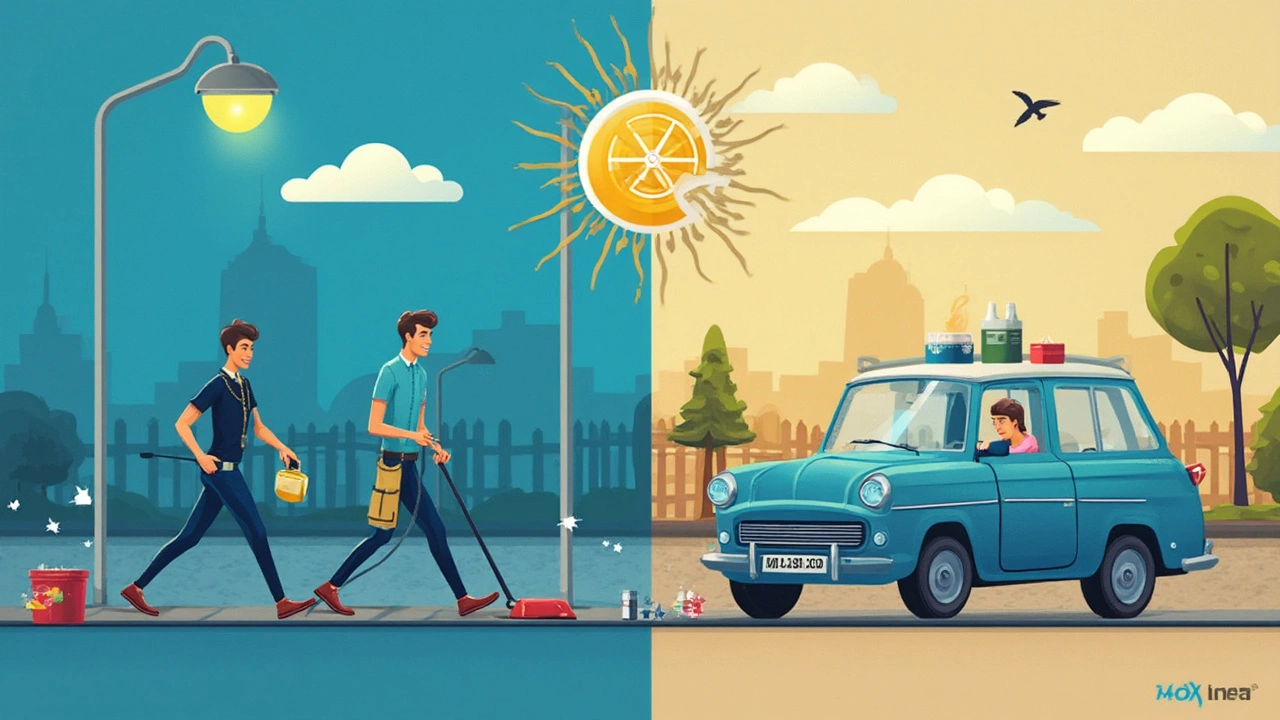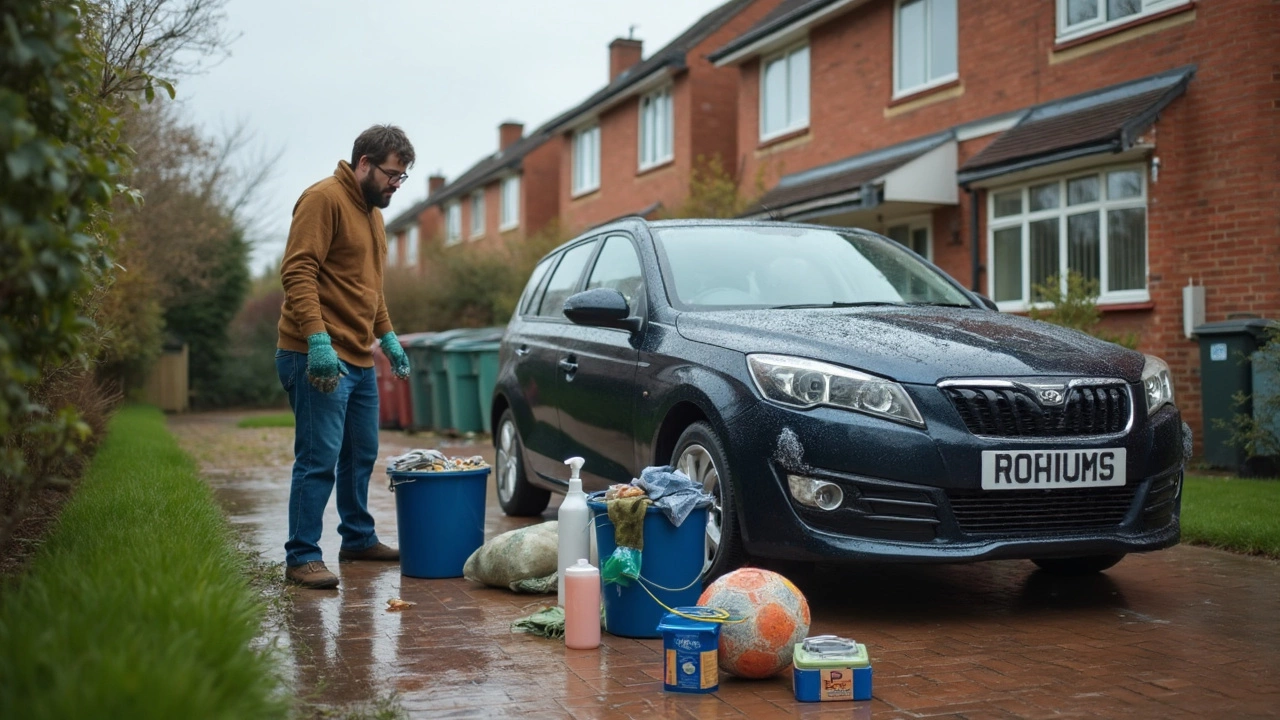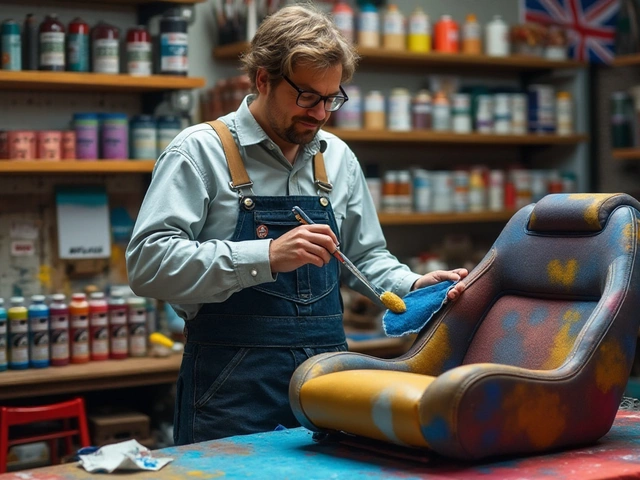Ever stare at your dirty car and wonder, “How much time am I really signing up for if I do this myself?” Here’s the straight answer: your first attempt at detailing a car—from vacuuming to that shiny finish—typically eats up three to five hours. And if you’re shooting for perfection or haven’t cleaned in ages, block out even more time.
People always think it’s just about a wash and vacuum. But true car detailing is way more: wheels, carpets, glass, plastics, and a finish that makes your car look better than when you bought it. Most people underestimate how long these steps take, especially once they get to stubborn bugs on the front bumper or mysterious stains on the seats.
There’s a reason even the pros take half a day or more. That’s why knowing what can slow you down—or speed things up—is a lifesaver, especially if you’ve only got an afternoon. So, let’s break down where that time goes and what you can do to actually enjoy the process—or at least not regret starting it before dinner.
- What Does Car Detailing Actually Include?
- Average Time Needed for DIY Detailing
- What Makes Detailing Faster or Slower?
- Tips for Speeding Up the Process
- Common Mistakes That Steal Your Time
- When to Call It Quits or Get Help
What Does Car Detailing Actually Include?
Most folks think car detailing is just another way to say car wash. That’s not even close. When you actually dive into car detailing, it’s a deep clean—top to bottom, inside and out. You’re not just making the car look shiny; you’re getting rid of hidden dirt, grime, pet hair, food crumbs, and funky smells that regular washes miss.
Here’s what typical DIY car detailing covers:
- Exterior Wash: Scrubbing off all surface dirt, bugs, and road grime. Usually done with a two-bucket method to avoid putting scratches in your paint.
- Wheels and Tires: Cleaning brake dust and grime off rims and tires, then dressing up the rubber so it doesn’t look faded.
- Paint Decontamination: Using a clay bar to pull off stuff you can’t even see, like tiny bits of tar or tree sap. Skipping this step makes waxing a waste of time.
- Polishing (optional): Buffing out light scratches and swirl marks, but honestly, this part takes practice and extra equipment.
- Wax or Sealant: This is what gives your car that slick, glossy finish. It also protects the paint from the sun and grime between details.
- Interior Deep Clean: Vacuuming carpets, mats, seats, and all the little pockets that collect crumbs and receipts you forgot about.
- Upholstery Cleaning: Spot-cleaning stains or, for cloth seats, sometimes a full shampoo. Leather seats get a special conditioner.
- Glass Cleaning: Getting rid of smudges, fingerprints, and fog inside and out. No streaks allowed.
- Plastic & Vinyl Treatments: Wiping down and protecting all the on-dash plastics, door panels, and cup holders. No one likes shiny dust magnets.
If you want to get a feel for how much time you’ll spend, check out this average DIY breakdown:
| Detailing Step | Average Time Needed |
|---|---|
| Exterior Washing | 35 minutes |
| Wheels & Tires | 20 minutes |
| Clay Bar & Decontam | 30 minutes |
| Wax/Sealant | 25 minutes |
| Interior Vacuuming | 30 minutes |
| Upholstery & Mats | 20 minutes |
| Glass Cleaning | 15 minutes |
| Plastics/Vinyl | 10 minutes |
Of course, if your car’s been neglected or you’re fighting kid stains and pet hair, add another hour or so. Each step builds on the next, so skipping one usually messes up the end result. Once you’ve seen what a fully detailed car looks and smells like, you can’t really go back to quick spray-and-wipe jobs.
Average Time Needed for DIY Detailing
When you check out forums or talk to folks at the car wash, most will tell you a full DIY job isn't just an hour-long Saturday thing. Depending on how dirty your car is, what tools you use, and your experience level, you’re looking at anywhere from 2 to 6 hours—and that’s if you’re going for everything, inside and out.
Here’s a look at what usually eats up your day during a typical car detailing session:
| Detailing Step | Average Time (minutes) |
|---|---|
| Washing Exterior | 30-45 |
| Drying | 10-15 |
| Vacuum Interior | 25-40 |
| Wiping Dash & Panels | 15-30 |
| Cleaning Windows | 10-20 |
| Cleaning Wheels & Tires | 20-30 |
| Wax or Sealant | 30-50 |
For most people, that means treating your ride to a full car detailing experience will run about 3 to 5 hours total—if you’re moving at a good pace and don’t run into any surprises. Someone doing this first time usually lands closer to the longer end because they’re figuring out tools, scratching their head over which towel is for glass, and maybe just enjoying the process a bit too much.
If you’re just hitting the basics—like a wash, a quick interior vacuum, and window wipe—you can do it in under 90 minutes. But if you want that show-car finish, block out a chunk of your day and don’t make any big plans right after. Clear off your calendar, grab some snacks, and maybe put on your favorite playlist. Time goes faster when you’re dialed in and having fun.
What Makes Detailing Faster or Slower?
Your time sink here really depends on a few key things. You might finish in a couple of hours, or spend an entire afternoon, all because of factors people barely think about when they start.
First, let’s talk about your car’s condition. If it’s been ignored for months, you’ll spend a lot more time scrubbing old stains, caked-on brake dust, or sticky spills. Newer cars, or ones cleaned regularly, are way easier and faster to detail. Think of it like cleaning your kitchen—wipe it daily and it’s a breeze; skip it for two weeks, and you’re in deep.
How much gear you have ready, and how organized it is, matters a ton too. Digging in the garage for your microfiber towels isn’t just annoying—it eats up real minutes. Professional detailers keep everything in arm’s reach for a reason. Lay out all your car detailing stuff before you start and you’ll cut time right away.
Skill level is another biggie. When you’re new to detailing, you move slower, double-check steps, and sometimes redo stuff you missed. Regulars know the order, which tools cut through what, and little tricks to avoid silly mistakes. Don’t sweat this—everybody speeds up with practice.
The size and type of your car come into play too. A compact sedan is just faster to detail than a van or big SUV. More surface means more work. Dark colored cars also show every missed spot, so you spend longer making them look just right, while white cars hide dust better and can speed things up.
Weather can trip you up, believe it or not. On hot sunny days, products like wax or soap might dry too fast and leave marks, so you’ll spend extra time re-doing certain steps. Cloudy or cooler days make the job go smoother. Bonus tip: A shaded driveway is gold when you’re detailing.
| Factor | Speeds It Up | Slows It Down |
|---|---|---|
| Car Condition | Regularly cleaned | Rarely washed, lots of debris |
| Supplies Organized | Laid out in advance | Hunting for gear mid-job |
| Skill & Experience | Knows the steps cold | Learning as you go |
| Vehicle Size/Type | Small sedan, coupe | Large SUV, minivan |
| Weather | Cool, shaded, not windy | Hot, direct sun, rain |
If you want to knock serious time off your DIY detail, here’s the cheat code: regularly maintain your ride, keep your kit stocked and ready, and pick a day with easy weather. Being realistic about what slows you down is a game-changer if you’d rather not spend Saturday hunched over your floor mats.

Tips for Speeding Up the Process
If you don’t want to spend your whole Saturday with a vacuum in one hand and a microfiber towel in the other, you’ve got to work smart. The first step? Get your gear ready up front. There’s nothing worse than realizing your glass cleaner is empty halfway through. Lay out your products and tools in the order you’ll use them. Going back and forth to your garage or storage can easily add half an hour to your project.
Use a car detailing kit instead of grabbing random products. Kits save loads of time because everything is made to work together. Many of them come with both interior and exterior cleaners, towels, even special brushes for trims and wheels. Some numbers for you: a survey from a major automotive retailer in 2023 found that DIYers using full detailing kits finished up to 30% faster than those piecing products together.
Work top to bottom. Gravity is your friend. Start with the roof and move down when washing or wiping. Anything dusty or dirty falls to the lower panels, so you won’t have to redo spots you cleaned early on.
Microfiber towels are game changers. They pick up dirt quicker and don’t leave those annoying streaks. If you use old t-shirts or worn-out sponges, you’ll end up scrubbing the same spot repeatedly.
Don’t forget about the little machines that can help. A cordless vacuum saves a ton of setup and takedown time over lugging out the shop vac and finding extension cords. For seats and carpets, a portable spot-cleaner pulls out spills like nothing else and dries faster, so you aren’t waiting around for hours.
Here's a quick breakdown to show how much time certain habits actually save:
| Techniques & Tools | Average Time Saved |
|---|---|
| Using a full detailing kit | 30-45 minutes |
| Laying out equipment beforehand | 20 minutes |
| Cordless vacuum vs. plug-in | 15-20 minutes |
| Microfiber towels over cotton | 10 minutes (plus better results) |
| Top-down cleaning order | 10-15 minutes |
One last tip: don’t forget refreshments—seriously. If you take fewer breaks to hunt for a water bottle or snacks, you shave even more time from your detail. Set up everything in one place, put your head down, and power through. You’ll be admiring your clean car before you know it.
Common Mistakes That Steal Your Time
The biggest time-waster? Not being organized from the start. If you’re constantly running back inside for a missing brush or searching for your favorite microfiber towel, you’ll burn an hour without realizing. Grab all your tools, chemicals, and your car detailing kit before you even touch the car.
Another trap is skipping the vacuum step because the car doesn’t look that bad. Dirt and crumbs turn into sticky messes when you hit them with cleaning spray later, and then you have to go back over the same spots. That’s just double work and wasted time.
Using the wrong cleaning products or not reading labels slows you down and risks damaging surfaces. I see people grab household cleaners for car plastics or use a single dirty rag for every step. You’ll have to redo parts, or worse, cause streaks and stains that are a pain to fix.
- Starting in the sun—cleaners dry too fast and leave spots, so you have to repeat washes or polish again.
- Not dealing with stains or bird droppings early—these get harder to remove the longer you wait. Five extra minutes now can save you half an hour of scrubbing later.
- Polishing before washing—the single fastest way to turn a two-hour job into an all-day affair. You’ll spread grit everywhere and end up back at square one.
Time burn also happens if you attack the process with no system. You’ll bounce from one side of the car to the other, missing spots or having to repeat steps. Always go top to bottom and work in sections.
| Mistake | Extra Time Wasted (Avg) |
|---|---|
| Lack of supplies ready | 30-45 minutes |
| Backtracking tasks | 20-35 minutes |
| Not cleaning in shade | 15-40 minutes |
| Wrong products/tools | 20-60 minutes |
Put simply: have all your stuff close by, follow a routine, and pay attention to surfaces before you hit them with cleaner. It’s not just about speed. It’s doing it once, doing it right, and not wishing you’d just paid your neighborhood detailer instead.
When to Call It Quits or Get Help
Sometimes DIY just doesn’t cut it—no shame in that. If you’re three hours in and still battling mud stains or funky odors, it’s time to reassess. Some stuff, like mold under floor mats, deep pet hair, or heavy salt buildup, seriously needs pro-grade tools. Heck, some stains just laugh at the average vacuum.
Here are a few clear signs it’s probably smarter (and less frustrating) to tag in a pro:
- You’re dealing with big-time interior spills: coffee, milk, or anything that’s soaked deep into the fabric.
- There’s tough chemical fallout on your paint—thinking tree sap, road tar, or sticky residue you can’t shift with regular soap.
- The smell just won’t leave—especially smoke, pet, or mildew odors that hang around, even after air freshener.
- You notice odd interior mold or everything feels damp and musty after cleaning.
- Your time is already maxed out, and you haven’t even hit the halfway point on your car detailing kit.
It’s not just about saving effort—it’s about results. A pro can get your car back in shape in 2–4 hours for most jobs, and honestly, their vacuum alone is stronger than anything you’ll get at the hardware store. Plus, you’ll avoid making things worse. Many folks rub leather the wrong way or leave water spots in awkward places on their first try.
Here’s a quick breakdown on when DIY works and when pro help pays off:
| Situation | DIY? | Call a Pro? |
|---|---|---|
| Quick wipe and light vacuum | Yes | No |
| Regular dirt, dust, fingerprints | Yes | No |
| Deep-seated stains or mystery odors | No | Yes |
| Paint overspray, serious scratches | No | Yes |
| Time limited (less than 2 hours free) | No | Yes |
Tackling your ride with a car detailing kit is awesome for maintenance and regular clean-ups, but there’s a line. When you hit that wall, don’t throw your whole Saturday at it. Sometimes paying fifty bucks for a pro saves you headaches and gives your car that new-car smell again. That’s just smart planning.






